At the 2012 Northwest Tea Festival, I met this guy.

The man in my crappy photo is Jeffrey McIntosh. Granted, his version of spelling “Geoffrey” is not the original—as mine is—but no one is perfect. However, he does hold the distinct honor of being one of the first people (younger than me) to blow my mind. During a talk he gave at the festival, he mentioned that puerh teas all came from different cultivars from one tea tree variety—the Camellia sinensis var. assamica.
Okay, for the very well-educated tea geek, that’s not exactly earth-shattering news. But four years ago, that changed my whole worldview, man. I thought that variety only grew in Assam, India because of the name.
Since that time, I kept a casual “online tea stalker”-y on his career. We had a couple of conversations (mainly because of our “similar” names), but nothing too heady. Around early 2015-ish, he launched a monthly subscription service called Teabook, which was a rousing success. Mainly because . . . well . . . the dude knew his stuff; he knew where to find good tea.
I finally encountered him again—in the real world—at World Tea Expo this year.

Not sure what went through our minds here.
On the last day of the Expo, he passed along this.
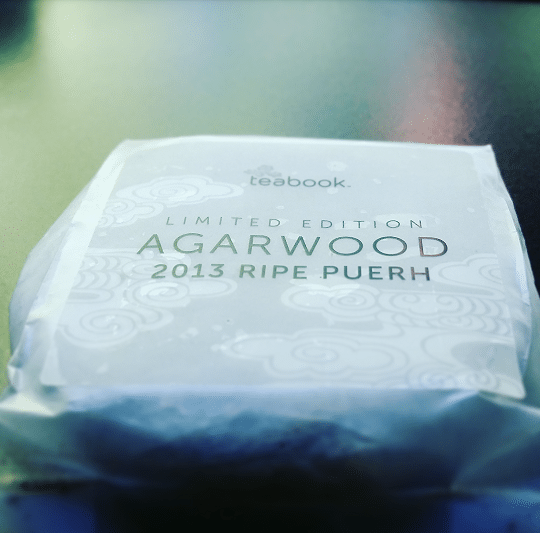
He tried to explain to me what it was, but I’ll admit I was only half-paying attention. Something about “sick tea trees” and “hardened wood”. (I giggled at “hardened wood”.) Other than that, I thought it was just any normal, run-of-the-mill cooked puerh cake. It was probably a good puerh cake, given who sourced it . . . but cooked puerh wasn’t really my thing.
So, after Expo, I let it just sit there in the “to-drink” pile.
Every once in a while, I got a message from Jeff:
“Have you tried it yet?”
“No.”
“How ‘bout, now?”
“No.”
“Are you there, yet?”

Even tea friends were trying to convince me that I had to get to that tea ASAP.
My main reason for putting it off was the move. Yes, I moved. Brewing up a new tea meant taking pretty-ish, blog-ready-ish photos. And I was too damned lazy to unpack and set up the tea station. This is what it looked like for a good month-and-a-half.
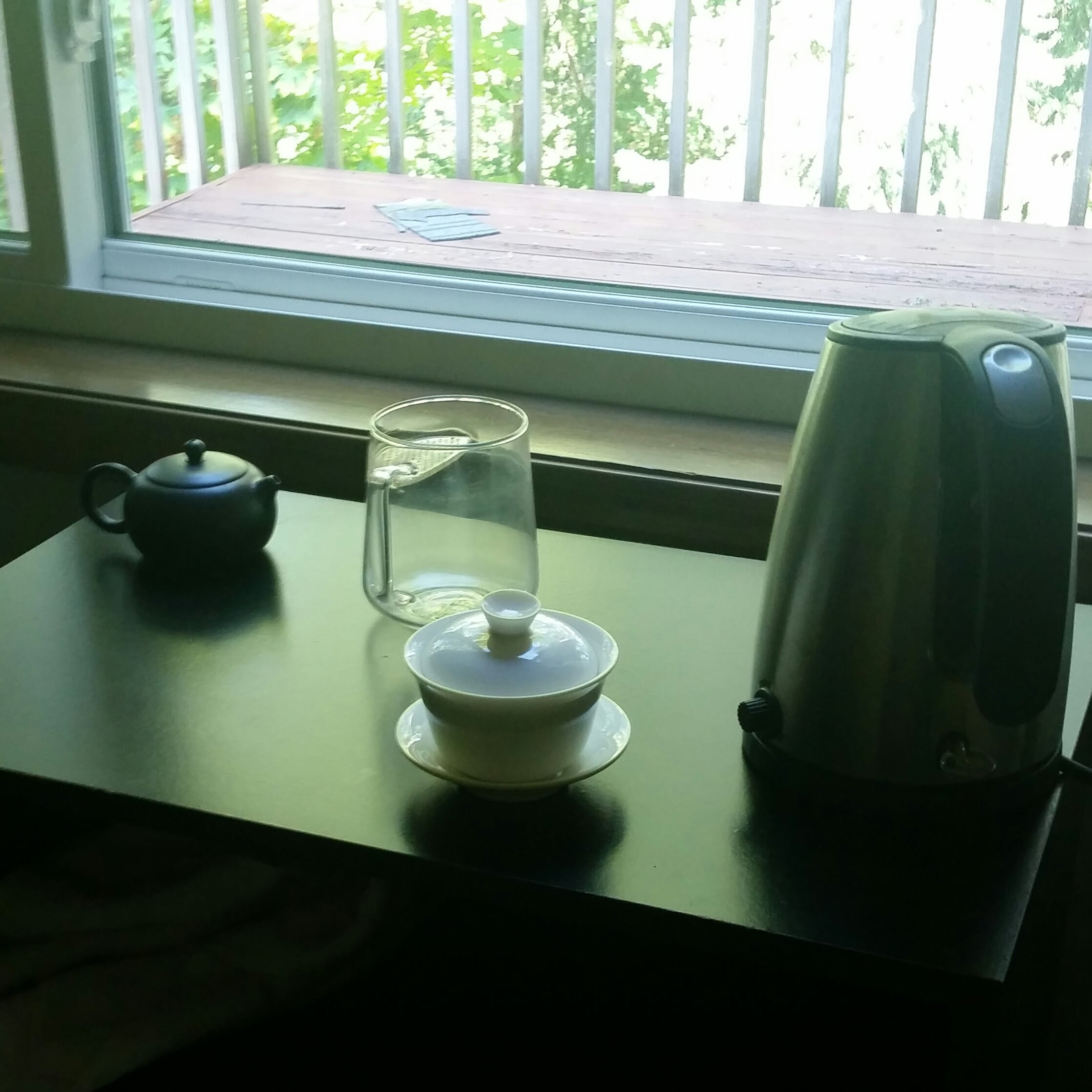
Finally, I decided to do some research, and looked up what all the fuss was about regarding this “agarwood” malarkey.
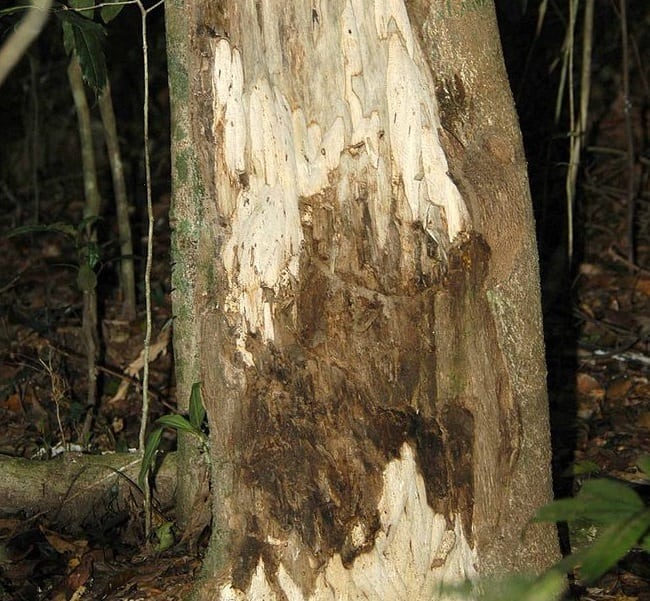
And I was floored.
For those who don’t know, agarwood is a dark, fragrant wood that forms inside two species of evergreen trees in southeast Asia—Aquilaria and Gyrinops. Normally, the heartwood of these trees is odorless and nondescript. But when they are infected by different types of mold, the tree itself produces an aromatic resin to combat it, thus coating the heartwood.
The odor that this adulterated heartwood gives off is apparently pleasing to people. Harvesting the stuff in the wild is painstaking and rare. The asking price for pure agarwood can go for, say, $100K a kilogram. The wood is used for a variety of purposes: distilled into oils, fancy-shmancy health products, and even blended in tea.
Good ol’ Jeffrey somehow commissioned a puerh factory to add chips of the stuff into fifty puerh cakes. The reason? He’d had one before, remembered the taste vividly, and wanted to make more. The going price for just one 100g beeng was $500. It was like gold pressed into a drinkable cake form. And now I had one.
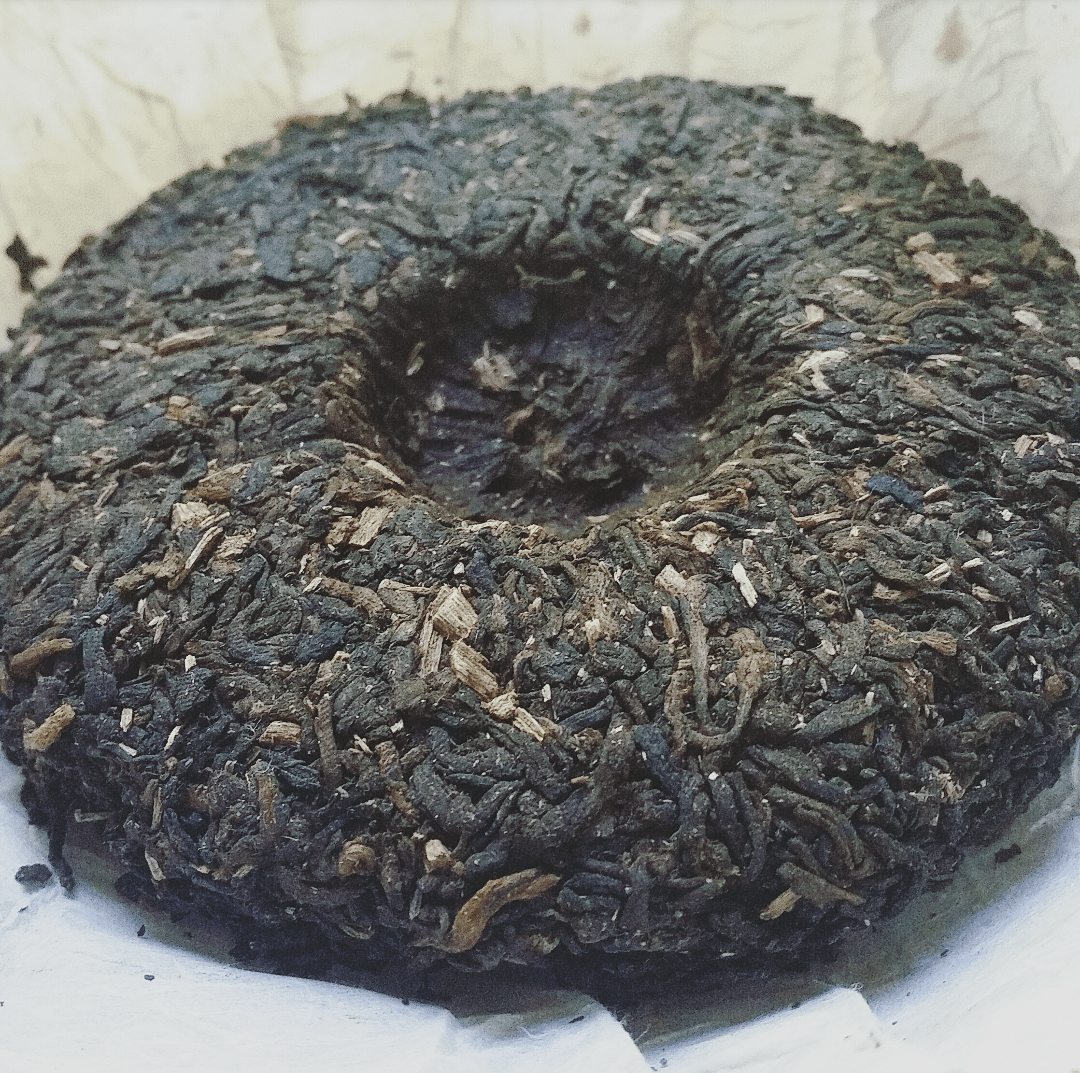
That was enough to convince me to finally set up the ol’ tea station.
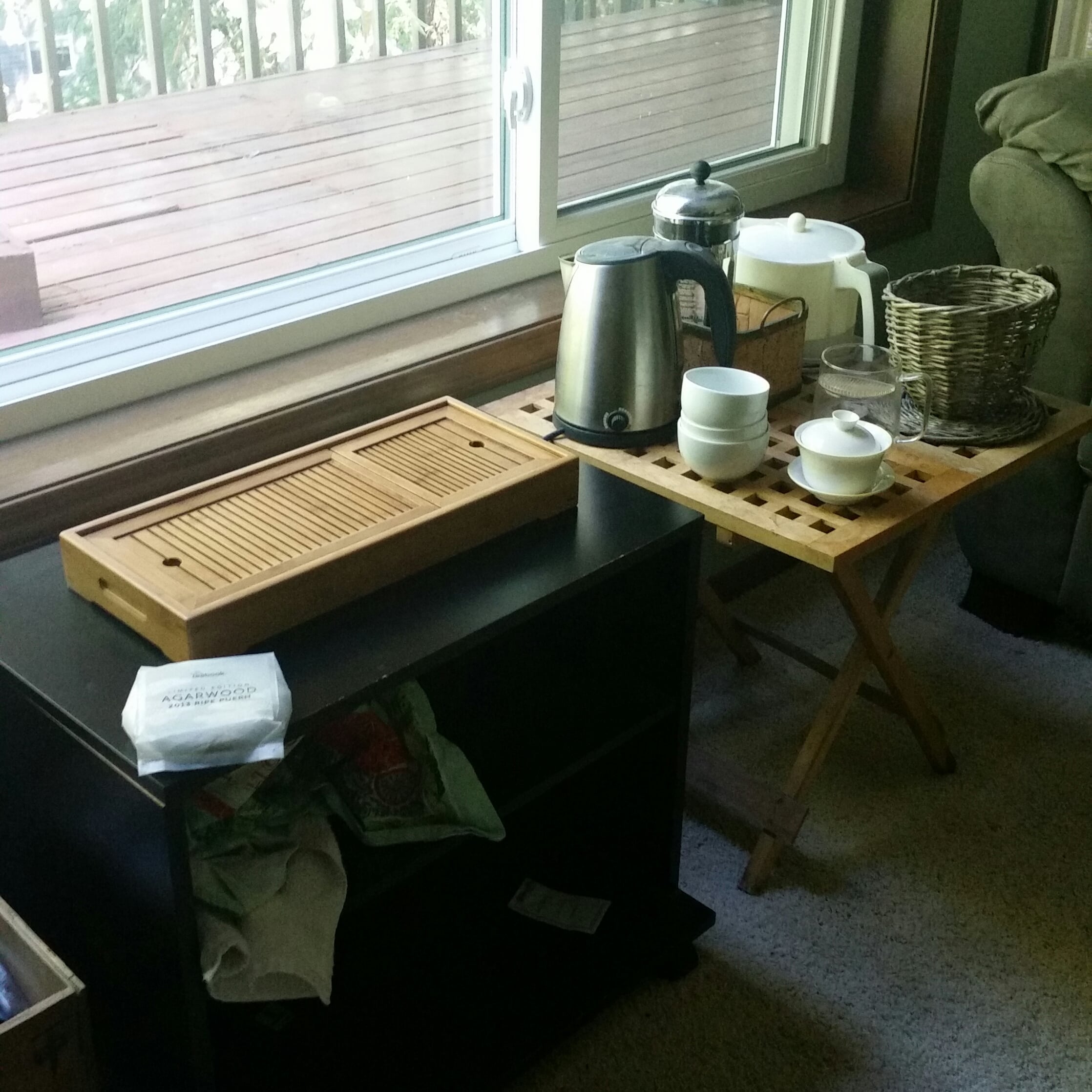
My first impression was that the cake was very loosely pressed. When undoing the wrapper, I had to do so over a garbage bag because there was plenty of fallen puerh debris. I mourned their loss. Besides that . . .
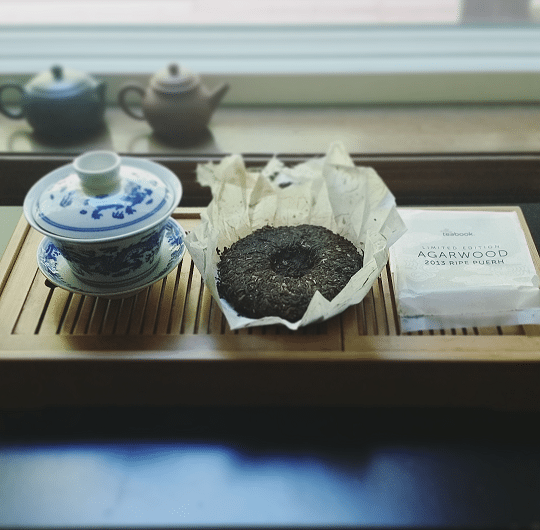
It was a very lovely cake—looked like many other cooked puerh beengs I’ve come across. Save for the very obvious addition of beige wood flecks to the tea tapestry. The agarwood chips gave it a “gold-tipped black tea” appearance—kinda?—but it was still very much its own thing entirely. The aroma started off very aged cooked puerh-ish, shades of “ocean shore” and earth, but there was something mellower on the backend. I couldn’t put my finger or nose on what it reminded me of. Oh yes! New home smell!
For brewing, I wasn’t sure what the best amount to chisel off was. It’d been a few months since I’d done puerh mostly traditionally-ish. So, I went with the old adage: “Cover the bottom of the gaiwan, and you’re good.” (Nicole “Tea For Me Please” Martin taught me that.)

Since this was a special occasion, I broke out my fancy Yunnan-glazed gaiwan. That and I actually did a pre-wash on the cake chisel! Aren’t y’all proud! I usually just went straight for the infusions. (Jeffrey later informed me that I didn’t have to pre-wash it, due to the high standards in the factory where it was produced.)

Don’t worry, I drank the pre-wash later.
For the rest of the real infusions, I went with boiled water and a thirty-second steep, for the first two. Latter two, I pushed it up to forty. Even at just the thirty-second push, the first infusion brewed black as night—as expected.
The aroma from the cup’s steam was earthy but smooth. Honestly, pretty typical; nothing special thus far. Then I took a sip, shrugging and . . . OH MY SWEET BUDDHA-JESUS!
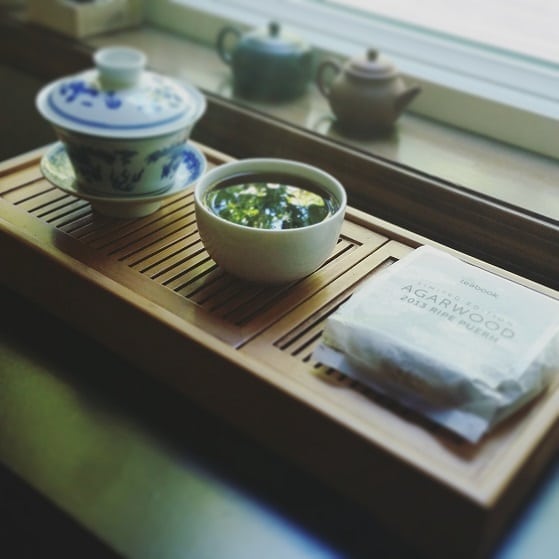
I just . . . whoah.
The introduction started off normal enough, but then things went all sorts of topsy-turvy in the top note. I detected fruit of some sort, mellow beet sugar sweetness, and the ghost of Pier 1 scented candles’ past. And that trail-off wasn’t exactly woody, it was . . . like someone—somehow!—managed to turn tree bark into silk-textured and room temperature magma. For my face.
Further infusions turned up equally transcendent results—the second and third infusions in particular. The fruity fragrance really took point, then, followed by a smooth blanket of flowers, earth, soul-searching meditation, and trips to dimensions unknown. This was probably the first time where my tongue and brain felt . . . the same. Fuzzy, comfortably numb, experiencing an overload of emotions and palatial primacy—you know, the unusual.
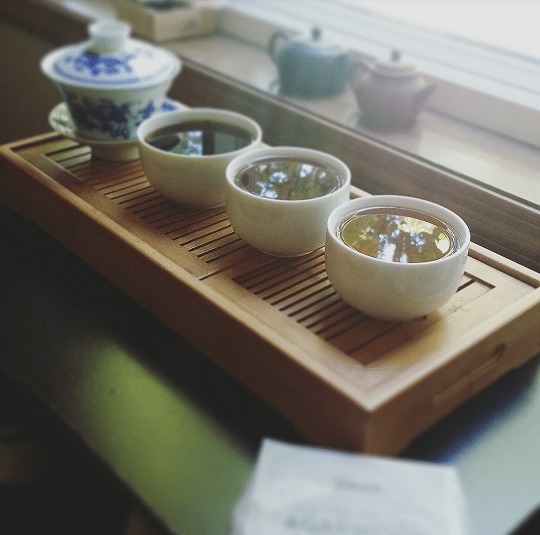
Of course, as I was sipping this in real-time, I was relaying my taster notes (if they even qualify as that) to my online tea circle. In response, Jo “A Gift of Tea” Johnson made this on the fly.

There were also very loud desires for slivers of the cake in my possession. I’m usually really good about sharing my finds with people. But this time? Nope, I had to be stingy. This was top-shelf, century-old whiskey heirloom type stuff here. Only brought out on special occasions.
Are you happy, now, Mr. McIntosh? You’re now the only person younger than me who has blown my mind twice. Not an easy feat. (My first name is still better, though.)
To buy Agarwood Puerh, go HERE.
Jeffrey McIntosh also recently did an article for Fresh Cup Magazine, you can find that HERE.
Leave a Reply